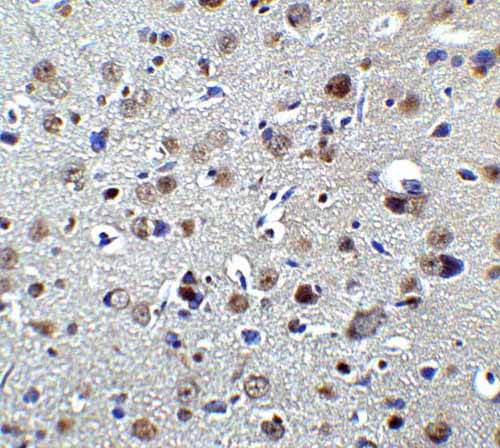HOOK3 Antibody
- SPECIFICATION
- CITATIONS
- PROTOCOLS
- BACKGROUND

Application
| WB, IHC-P, IF, E |
|---|---|
| Primary Accession | Q86VS8 |
| Other Accession | NP_115786, 84376 |
| Reactivity | Human, Mouse, Rat |
| Host | Rabbit |
| Clonality | Polyclonal |
| Isotype | IgG |
| Calculated MW | Predicted: 79 kDa Observed: 77 kDa |
| Application Notes | HOOK3 antibody can be used for the detection of HOOK3 by Western blot at 1 - 2 μg/mL. Antibody can also be used for immunohistochemistry at 10 μg/ml. |
| Gene ID | 84376 |
|---|---|
| Target/Specificity | HOOK3 antibody was raised against a 19 amino acid peptide from near the amino terminus of human HOOK3. The immunogen is located within amino acids 210 - 260 of HOOK3. |
| Reconstitution & Storage | HOOK3 antibody can be stored at 4℃ for three months and -20℃, stable for up to one year. |
| Precautions | HOOK3 Antibody is for research use only and not for use in diagnostic or therapeutic procedures. |
| Name | HOOK3 (HGNC:23576) |
|---|---|
| Function | Acts as an adapter protein linking the dynein motor complex to various cargos and converts dynein from a non-processive to a highly processive motor in the presence of dynactin. Facilitates the interaction between dynein and dynactin and activates dynein processivity (the ability to move along a microtubule for a long distance without falling off the track). Predominantly recruits 2 dyneins, which increases both the force and speed of the microtubule motor (PubMed:25035494, PubMed:33734450). Component of the FTS/Hook/FHIP complex (FHF complex). The FHF complex may function to promote vesicle trafficking and/or fusion via the homotypic vesicular protein sorting complex (the HOPS complex). May regulate clearance of endocytosed receptors such as MSR1. Participates in defining the architecture and localization of the Golgi complex. FHF complex promotes the distribution of AP-4 complex to the perinuclear area of the cell (PubMed:32073997). |
| Cellular Location | Cytoplasm, cytoskeleton. Golgi apparatus. Note=Enriched at the cis-face of the Golgi complex. Localizes to microtubule asters in prophase (PubMed:11238449). Localizes to the manchette in elongating spermatids (By similarity). {ECO:0000250|UniProtKB:Q8BUK6, ECO:0000269|PubMed:11238449} |

Thousands of laboratories across the world have published research that depended on the performance of antibodies from Abcepta to advance their research. Check out links to articles that cite our products in major peer-reviewed journals, organized by research category.
info@abcepta.com, and receive a free "I Love Antibodies" mug.
Provided below are standard protocols that you may find useful for product applications.
Background
The HOOK proteins (HOOK1, HOOK2 and HOOK3) comprise a family of cytosolic coiled-coil proteins that contain conserved N-terminal domains, which attach to microtubules mediating the spatial organization of diverse membrane-trafficking systems; their more divergent C-terminal domains mediate binding to organelles (1,2). HOOK3 exists as a homodimer and participates in defining the architecture and localization of the Golgi complex through its central coiled-coil domain (3). HOOK3 may regulate clearance of endocytosed receptors such as MSR1 (3,4).
References
Walenta JH, Didier AJ, Liu X, et al. The Golgi-associated hook3 protein is a member of a novel family of microtubule-binding proteins. J. Cell Biol. 2001; 152:923-34.
Sano H, Ishino M, Krämer H, et al. The microtubule-binding protein Hook3 interacts with a cytoplasmic domain of scavenger receptor A. J. Biol. Chem. 2007; 282:7973-81.
Herrmann L, Wiegmann C, Arsalan-Werner A, et al. Hook proteins: association with Alzheimer pathology and regulatory role of hook3 in amyloid beta generation. PLoS One 2015; 10:e0119423.
Ciampi R, Giordano TJ, Wikenheiser-Brokamp K, et al. HOOK3-RET: a novel type of RET/PTC rearrangement in papillary thyroid carcinoma. Endocr. Relat. Cancer 2007; 14:445-52.
If you have used an Abcepta product and would like to share how it has performed, please click on the "Submit Review" button and provide the requested information. Our staff will examine and post your review and contact you if needed.
If you have any additional inquiries please email technical services at tech@abcepta.com.













 Foundational characteristics of cancer include proliferation, angiogenesis, migration, evasion of apoptosis, and cellular immortality. Find key markers for these cellular processes and antibodies to detect them.
Foundational characteristics of cancer include proliferation, angiogenesis, migration, evasion of apoptosis, and cellular immortality. Find key markers for these cellular processes and antibodies to detect them. The SUMOplot™ Analysis Program predicts and scores sumoylation sites in your protein. SUMOylation is a post-translational modification involved in various cellular processes, such as nuclear-cytosolic transport, transcriptional regulation, apoptosis, protein stability, response to stress, and progression through the cell cycle.
The SUMOplot™ Analysis Program predicts and scores sumoylation sites in your protein. SUMOylation is a post-translational modification involved in various cellular processes, such as nuclear-cytosolic transport, transcriptional regulation, apoptosis, protein stability, response to stress, and progression through the cell cycle. The Autophagy Receptor Motif Plotter predicts and scores autophagy receptor binding sites in your protein. Identifying proteins connected to this pathway is critical to understanding the role of autophagy in physiological as well as pathological processes such as development, differentiation, neurodegenerative diseases, stress, infection, and cancer.
The Autophagy Receptor Motif Plotter predicts and scores autophagy receptor binding sites in your protein. Identifying proteins connected to this pathway is critical to understanding the role of autophagy in physiological as well as pathological processes such as development, differentiation, neurodegenerative diseases, stress, infection, and cancer.


